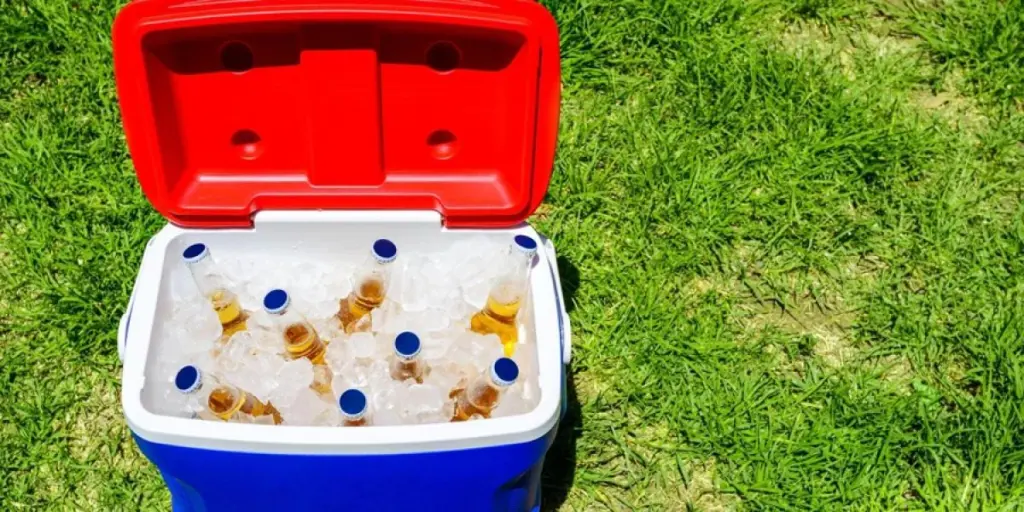Table of Contents
Introduction
Cooler Boxes’ Market Dynamics
How to Select the Best Products
Best Products/Models/Types and Their Features
Conclusion
Introduction
In 2024, cooler boxes have transcended beyond mere accessories for outdoor aficionados to become essential tools for a variety of users, ranging from adventure seekers to everyday consumers. The evolution in cooler box technology reflects a blend of innovative design and practical functionality, catering to a diverse market with evolving needs. These advancements have not only enhanced the efficiency of temperature maintenance but have also introduced a spectrum of features tailored for convenience and durability. This guide delves into the realm of cooler boxes, offering insights into selecting the best products in 2024 that align with both retail strategies and consumer expectations.
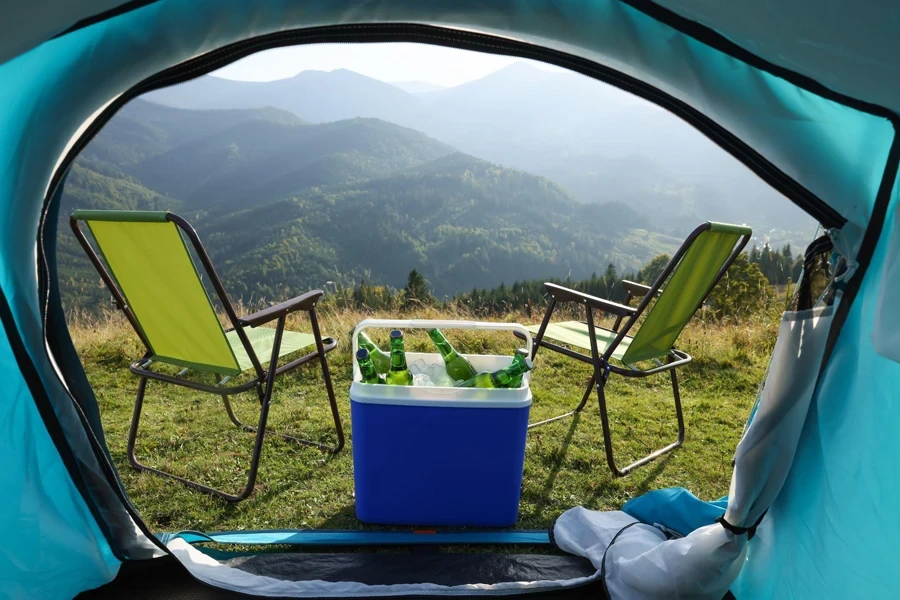
Cooler Boxes’ Market Dynamics
The global cooler box market size has been valued differently across various sources. Zion Market Research, on the other hand, valued the market at USD 5 billion in 2022 and projected it to reach USD 9.5 billion by 2030.Transparency Market Research predicted a higher value, expecting the market to reach USD 13.4 billion by 2031, growing at a CAGR of 11.2%. Mordor Intelligence reported that the market generated a revenue of USD 5.6 billion in the current year and is poised to achieve a CAGR of 10% for the forecast period.
The market is segmented by type into reusable and disposable cooler boxes. Mordor Intelligence reported that the reusable segment dominated the market, accounting for 67% of the total market share. The market is also segmented by raw material into polyurethane foam, expanded polystyrene, extruded polystyrene, expanded polypropylene, among others. Key players in the cooler box market include Sonoco Thermosafe, B Medical System, Blowkings, ISONOVA, Eurobox Logistics, Softbox Systems Ltd., va-Q-tec AG, Cold Chain Technologies, Inc., Sofrigam Group, FEURER GmbH, Igloo, Wild Coolers, K2 Coolers, Cool Ice Box Company, and Bison Coolers.
The cooler box market in North America was valued at USD 4.6 billion in 2020 and is projected to reach USD 8.1 billion by 2025, growing at a CAGR of 12.1%. However, the Asia Pacific region, notably countries like China, India, Japan, and South Korea, is poised for substantial growth, leveraging lower manufacturing costs and increased production.
How to Select the Best Products
Choosing the right cooler box goes beyond basic functionality. It involves considering a myriad of factors to ensure the product not only meets the specific needs of the user but also offers durability, efficiency, and value for money. Here’s an enriched perspective on the key factors:
Types of Construction:
- Rotomolded Construction:
- Characterized by a single, continuous piece of plastic, rotomolded coolers are known for their exceptional durability and strength.
- Ideal for rugged outdoor activities due to their ability to withstand harsh conditions without cracking or breaking.
- Typically offer superior insulation, keeping contents cold for extended periods.
- Injection Molded Construction:
- Involves injecting molten plastic into a mold to form the cooler.
- Tends to be more affordable than rotomolded coolers.
- Offers good durability and insulation, suitable for general use.
- Blow Molded Construction:
- A process where plastic is melted and blown into a mold.
- Often used for more budget-friendly coolers.
- Provides reasonable durability and insulation, suitable for casual or less intensive use.
- Fabric Softshell Construction:
- Made from high-quality, durable fabrics.
- Lightweight and portable, ideal for short trips or day outings.
- Often includes additional pockets and features for convenience but generally offers less insulation than hard-shell coolers.
- Metal Coolers:
- Constructed primarily from metals like steel or aluminum.
- Known for their durability and classic design.
- Often heavier and may require more maintenance to prevent rusting, but excellent at retaining cold.
- Thermoelectric Coolers:
- Use electricity to cool contents, eliminating the need for ice.
- Ideal for use in vehicles or places where a power source is available.
- Offers convenience and temperature control but is dependent on external power sources.
- Hybrid Coolers:
- Combine features of hard and soft coolers.
- Offer versatility with reasonable insulation and durability.
- Suitable for a variety of situations, balancing portability with performance.

Materials (Insulation Efficiency):
- Polyurethane Foam (PU Foam):
- Widely used in high-end coolers due to its excellent insulating properties.
- Provides superior thermal resistance and helps maintain low temperatures for extended periods.
- Often found in rotomolded and injection-molded coolers.
- Polystyrene Foam:
- Commonly used in both hard-sided and soft-sided coolers.
- Includes expanded polystyrene (EPS) and extruded polystyrene (XPS), both known for good insulation.
- Lightweight and cost-effective, but typically less durable than polyurethane foam.
- Expanded Polypropylene (EPP):
- Known for its excellent thermal insulation, shock absorption, and water resistance.
- More durable and resilient than polystyrene, making it suitable for rugged use.
- Used in some premium coolers for its balance of insulation and durability.
- Rubber or Silicone Seals:
- Used for sealing lids and doors in coolers to prevent air exchange.
- Enhances insulation by creating a tight seal that keeps cold air in and warm air out.
- Vital for maintaining the efficiency of the cooler.
- Fabric Insulation (for Soft Coolers):
- Soft coolers often use layers of fabric with insulating properties, like nylon or polyester.
- These fabrics are usually combined with a foam insulation layer.
- Offers moderate insulation, suitable for short-term use and convenience.
- Reflective Liners:
- Some coolers incorporate reflective Mylar or other materials as liners.
- Reflects heat away from the cooler, improving insulation efficiency.
- Often used in conjunction with other insulating materials for enhanced performance.
- Closed-Cell Foam Insulation:
- Provides excellent thermal resistance and water resistance.
- Does not absorb water, making it ideal for coolers used in wet environments.
- Commonly found in high-quality coolers where long-term insulation is crucial.
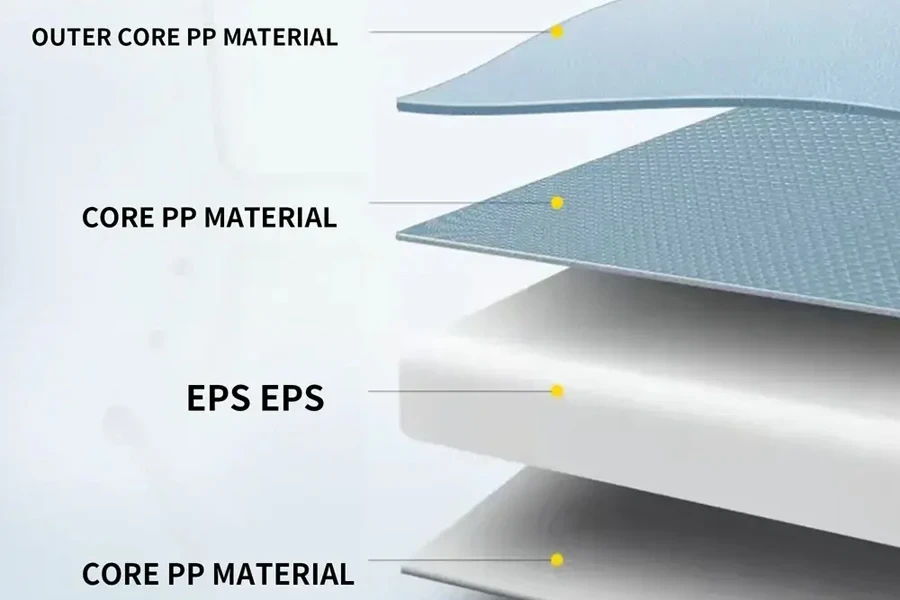
Size and Capacity:
- Small Coolers (Personal or Lunch Coolers):
- Typically range from 5 to 20 quarts.
- Ideal for individual use, picnics, or short day trips.
- Can hold a small meal, snacks, and several beverages.
- Medium Coolers:
- Range from 20 to 40 quarts.
- Suitable for small family outings or weekend camping trips.
- Can accommodate meals and drinks for a couple of days for a small group.
- Large Coolers:
- Capacity ranges from 40 to 100 quarts.
- Designed for longer camping trips, large gatherings, or fishing expeditions.
- Can store multiple days’ worth of food and drinks for a larger group.
- Extra-Large Coolers:
- Exceed 100 quarts.
- Used for extended trips, large events, or commercial purposes.
- Capable of storing a substantial amount of food, drinks, or game from hunting trips.
- Specialized Coolers:
- Designed with specific purposes in mind, like marine coolers, which often have larger capacities and reinforced construction for marine environments.
- Hunting coolers may include features like integrated game scales or specialized shapes for storing large game.
- Portability Considerations:
- As size and capacity increase, portability can become a challenge.
- Larger coolers may include features like wheels or handles for easier transportation.
- The shape of the cooler also impacts storage in vehicles and carrying comfort.
- Space Efficiency:
- Internal layout and design impact how effectively space can be used.
- Some coolers include compartments or separators for better organization.
- The ratio of insulation thickness to internal space is also a key consideration for maximizing storage while maintaining efficient insulation.
- Collapsible/Foldable Coolers:
- Some soft-sided coolers offer the advantage of being collapsible, saving space when not in use.
- Ideal for occasional use or when storage space is a concern.
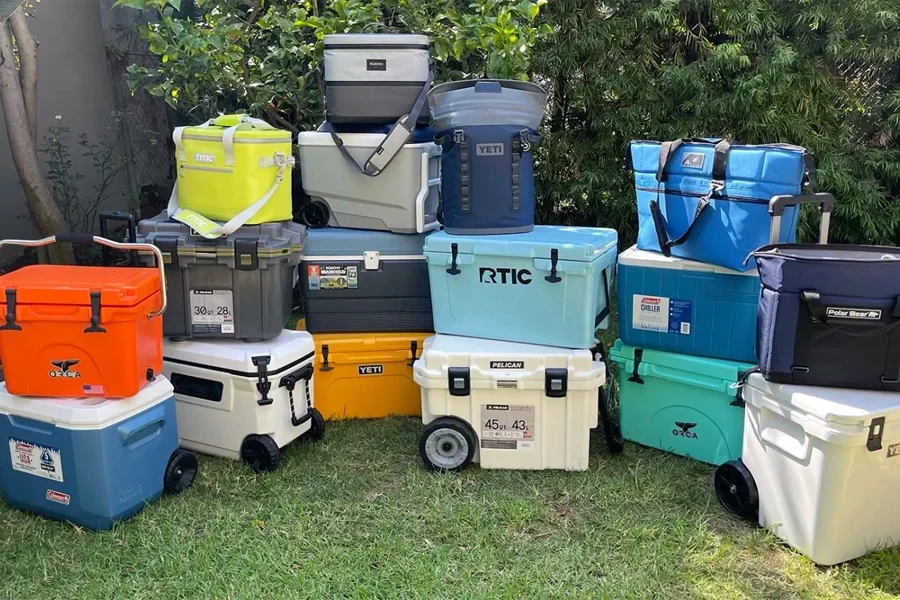
Different Environment and Usage Demand:
- Coolers for Challenging Environments:
- Ideal for outdoor adventures, off-grid camping, boating, or rough terrain.
- Construction: Look for rotomolded or heavy-duty plastic construction which offers enhanced durability and resistance to impacts.
- Insulation: High-quality insulation, such as thick polyurethane foam, is essential for maintaining temperature over extended periods.
- Sealing: Airtight seals and rubber gaskets help preserve cold air and protect contents from external elements.
- Size and Capacity: Larger coolers (40-100+ quarts) are preferred for longer trips, capable of storing enough supplies for several days.
- Additional Features: Features like tie-down slots, bear-proof locks, non-slip feet, and reinforced handles can be crucial.
- Portability: For extremely large coolers, consider models with wheels or handles for easier transportation in rough terrains.
- Coolers for Less Demanding Situations:
- Suitable for short day trips, picnics, or casual outdoor gatherings.
- Construction: Lightweight materials like plastic or fabric for soft coolers are sufficient. Injection-molded construction is a cost-effective option.
- Insulation: Moderate insulation is adequate; thinner foam layers or insulated fabrics can keep contents cool for several hours to a day.
- Size and Capacity: Smaller to medium-sized coolers (5-40 quarts) are more convenient for these situations, offering enough space for day-use supplies.
- Portability: Soft coolers with shoulder straps or smaller hard coolers with single-handle designs are ideal for easy carrying.
- Additional Features: Simpler features like external pockets for accessories, easy-to-clean interiors, and collapsible designs for storage are beneficial.

Price vs. Performance:
- Premium Cooler Boxes:
- Higher Price Tag: Often significantly more expensive due to advanced construction techniques, such as rotomolded designs, and high-quality materials.
- Superior Insulation: These coolers are designed to keep contents cold for extended periods, often several days, making them ideal for long trips or in environments where ice replenishment isn’t feasible.
- Enhanced Durability: Built to withstand rough handling and challenging environments, they are often the go-to choice for outdoor enthusiasts, fishermen, and hunters.
- Additional Features: May include bear-proof locks, built-in bottle openers, fish scales, and more ergonomic designs for ease of transport.
- Mid-Range Coolers:
- Moderate Price: These coolers strike a balance between affordability and performance.
- Good Insulation: Capable of keeping items cold for a reasonable amount of time, suitable for weekend camping trips or day outings.
- Reliable Durability: While they might not be as rugged as the premium options, they offer decent durability for general outdoor activities.
- Basic Features: Generally include essential features like sturdy handles and simple drain plugs.
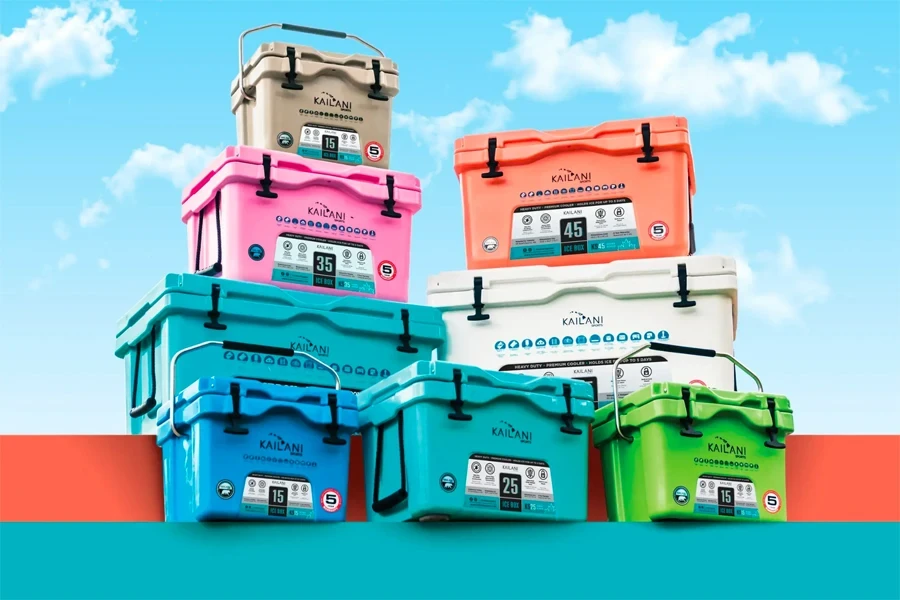
- Budget-Friendly Coolers:
- Lower Price Point: The most affordable options, ideal for consumers who need a cooler for occasional use or less demanding situations.
- Adequate Insulation: Designed for short-term cooling, suitable for day trips, picnics, or sporting events.
- Moderate Durability: May not endure harsh conditions as well as higher-end models but can handle typical use with care.
- Limited Features: Focus on basic functionality, with fewer added features compared to premium or mid-range coolers.
- Value for Money:
- It’s important to assess the intended use and frequency to determine whether investing in a high-end cooler is justified.
- For regular, intensive outdoor use, investing in a premium cooler can be cost-effective in the long run due to its durability and performance.
- For occasional or light use, a mid-range or budget cooler may offer the best value, providing adequate performance without the high price tag.
Top-notch Products and their features:
High-End Coolers:
- Yeti Tundra Series: Known for exceptional ice retention and durability, the Yeti Tundra series represents the pinnacle of cooler technology. These coolers feature rotomolded construction and permafrost insulation, making them virtually indestructible and capable of keeping ice frozen for extended periods. Ideal for serious outdoor enthusiasts who need reliability in harsh conditions.
- Features: Bear-resistant, T-Rex Lid Latches, and FatWall Design.
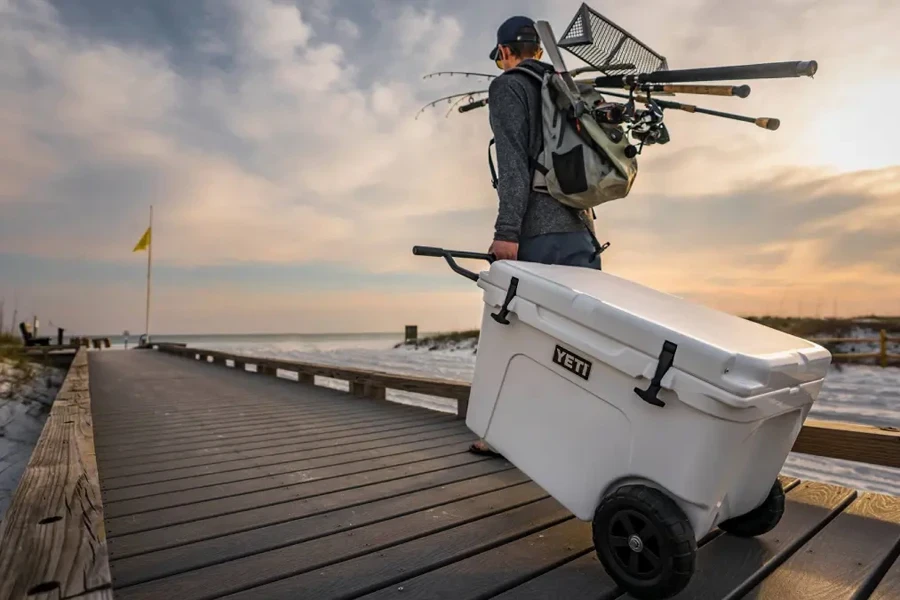
Budget-Friendly Coolers:
- Coleman Xtreme 5 Marine Cooler: The Coleman Xtreme 5 offers excellent value for money. It’s well-insulated, capable of keeping ice for up to 5 days at temperatures up to 90°F. The cooler is also equipped with a UVGuard material that protects it from the sun’s rays.
- Features: Leak-resistant drain, Have-A-Seat Lid, and comfort-grip handles for easy carrying.
Specialized Coolers (Lightweight/High-Capacity):
- Lightweight Option: RTIC Soft Pack Cooler: It’s praised for its portability and insulation efficiency, the RTIC Soft Pack is perfect for day trips or picnics. It’s designed with a high-density closed-cell foam insulation for excellent cold retention.
- Features: Lightweight design, waterproof zipper, and antimicrobial liner.
- High-Capacity Option: Pelican Elite Coolers: For those needing substantial storage capacity, the Pelican Elite series, noted by Wirecutter, offers large volume coolers with heavy-duty construction. They come with 2-inch polyurethane insulation and a 360-degree freezer-grade gasket.
- Features: Up to 10 days of ice retention, built-in bottle opener, and 4 self-draining cup holders.
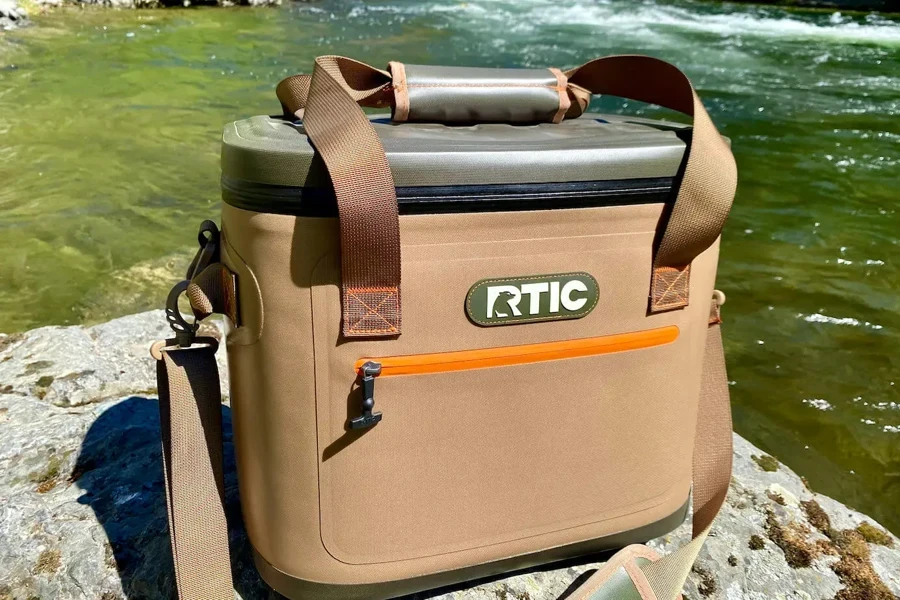
Innovative Feature Coolers:
- Igloo Recool Cooler: The Igloo Recool is an innovative environmentally-friendly option. Made from biodegradable materials, it’s a disposable cooler that offers decent insulation for short-term use.
- Features: Eco-friendly, lightweight, and compostable.
Backpack Coolers:
- Polar Bear Original Nylon Backpack Cooler: This cooler, as mentioned combines the convenience of a backpack with the functionality of a high-quality cooler. It’s ideal for individual use and short hikes.
- Features: Durable nylon exterior, open-cell foam insulation, and comfortable backpack straps.
Conclusion
The 2024 cooler box market presents an impressive array of options catering to a variety of needs and preferences. The key takeaway for retailers is the importance of understanding these diverse offerings and their unique features, ensuring that the range of products they provide aligns well with the varied requirements of end-users. Retailers should focus on selecting the right mix of cooler boxes based on durability, insulation efficiency, size, capacity, and additional features, while also considering the balance between price and performance. By doing so, they can effectively cater to the needs of outdoor enthusiasts, casual users, and everyone in between. Emphasizing the right selection based on these considerations will ultimately strengthen customer loyalty and market presence.
